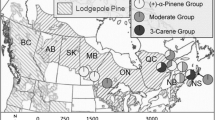Abstract
MaleI. paraconfusus confined to artificial entrance tunnels in white fir logs produced the pheromone compounds ipsenol and ipsdienol in their hindguts. The hindguts were attractive to females in a laboratory olfactometer and the male infested logs were attractive in field bioassay. The amount of pheromones produced and the amount of feeding and boring activity is much less in white fir than in ponderosa pine. There were no pheromones detected in the hindguts of recently emerged, unfed males.
Similar content being viewed by others
References
Bedard, W. D., andBrowne, L.E. 1969. A delivery-trapping system for evaluating insect chemical attractants in nature.J. Econ. Entomol. 62:1202–1203.
Browne, L.E. 1972. An emergence cage and refrigerated collector for wood-boring insects and their associates.J. Econ, Entomol. 65:1499–1501.
Byers, J.A. 1978. Mutual inhibition of the attractive response to pheromones ofDendroctonus brevicomis andIps paraconfuses, and the physiology of pheromone production inIps paraconfusus. PhD thesis. University of California, Berkeley, pp. 1–113.
Byers, J.A., Wood, D.L., Browne, L.E., Fish, R.H., Piatek, B., andHendry, L.B. 1979. Relationship between a host plant precursor, myrcene, and pheromone production in the bark beetle,Ips paraconfusus Lanier.J. Insect Physiol. 25:477–482.
Elkinton, J.S., andWood, D.L. 1980. Feeding and boring behavior of the bark beetleIps paraconfusus (Coleoptera: Scolytidae) on the bark of host and nonhost tree species.Can. Entomol. In press.
Hughes, P.R. 1974. Myrcene: a precursor of pheromones inIps beetles.J. Insect Physiol. 20:1271–1275.
Jantz, O.K., andRudinsky, J.A. 1965. Laboratory and field methods for assaying olfactory responses of the Douglas fir beetle,Dendroctonus pseudotsugae Hopkins.Can. Entomol. 97:935–941.
Lanier, G.N., andWood, D.L. 1975. Specificity of responses to pheromones in the genusIps (Coleoptera: Scolytidae).J. Chem. Ecol. 1:9–23.
Miller, R.G. 1966. Simultaneous statistical inferences. McGraw-Hill, New York, 272 pp.
Mirov, N.T. 1961. Composition of gum turpentine of pines. Tech. Bull. No. 1239, U.S. Department of Agriculture.
Silverstein, R.M., Rodin, J.O., andWood, D.L. 1966a. Sex attractants in frass produced by maleIps confusus in ponderosa pine.Science 154:509–510.
Silverstein, R.M., Rodin, J.O., Wood, D.L., andBrowne, L.E. 1966b. Identification of two new terpene alcohols from frass produced byIps confusus in ponderosa pine.Tetrahedron 22:1929–1936.
Vite, J.P., Gara, R.I., andKliefoth, R.A. 1963. Collection and bioassay of a volatile fraction attractive toIps confusus (LeC.) (Coleoptera: Scolytidae).Contrib. Boyce Thompson Inst. 22:39–50.
Wood, D.L., Browne, L.E., Silverstein, R.M.,andRodin, J.O. 1966. Sex pheromones of bark beetles I. Mass production, bioassay, source, and isolation of the sex pheromone ofIps confusus (Lec.)J. Insect Physiol. 12:523–536.
Wood, D.L., Browne, L.E., Bedard, W.D., Tilden, P.E., Silverstein, R.M., andRodin, J.O. 1968. Response ofIps confusus to synthetic sex pheromones in nature.Science 159:1373–1374.
Zavarin, E. 1968. Chemotaxonomy of the genusAbies II. Within-tree variation of the terpenes in cortical oleoresin.Phytochemistry 7:72–107.
Zavarin, E., andSnajberk, K. 1965. Chemotaxonomy of the genusAbies I. Survey of the terpenes present in theAbies balsams.Phytochemistry 4:141–148.
Author information
Authors and Affiliations
Additional information
Coleoptera; Scolytidae.
Research supported by the Rockefeller Foundation, an NIH training grant, USDA/SEA Regional Research Project W-110, and the USDA Forest Service.
From a thesis submitted by J.S. Elkinton in partial satisfaction of the requirements for the PhD degree, University of California, Berkeley, California, 1979.
Rights and permissions
About this article
Cite this article
Elkinton, J.S., Wood, D.L. & Hendry, L.B. Pheromone production by the bark beetle,Ips paraconfusus, in the nonhost, white fir. J Chem Ecol 6, 979–987 (1980). https://doi.org/10.1007/BF00994655
Received:
Revised:
Issue Date:
DOI: https://doi.org/10.1007/BF00994655




